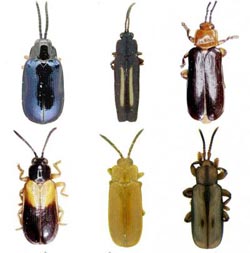Smithsonian scientists use DNA to quickly unravel relationship between plants and insects

This shows six of dozens of rolled leaf beetles collected in Costa Rica for the study. High-quality plant DNA was obtained from the gut contents of these beetles, revealing exactly which Zingiberales plants they had been eating.<br><br>Credit: Charles Staines<br>
It can take years for a researcher to fully understand the diets of a community of herbivorous insects in a tropical rain forest. Now, five Smithsonian scientists are paving a fast track using the DNA found inside the insects' stomachs, potentially turning years of research into months.
This method will help scientists understand the ecology and evolution of plant-herbivore interactions more efficiently. Their findings are published in the journal PLOS ONE.
Plants and insects comprise about 50 percent of all known species on Earth, forming the critical foundation of biodiversity in most terrestrial ecosystems. This study focused on 20 species of rolled leaf beetles in Costa Rica and 33 species of flowering plants in the order Zingiberales that the beetles eat and lay eggs on almost exclusively.
Using specialized DNA extraction methods the scientists obtained a mix of DNA both from the actual insect and from the insect's stomach contents. They used DNA markers specific to animals to obtain DNA barcodes for each insect species and markers specific to plants to identify the plant species in each insect's diet.
“What makes this study unique is that we developed DNA extraction techniques and full DNA barcode libraries that allowed us to identify host plants to the species level,” said Carlos García-Robledo, a post-doctoral fellow at the Smithsonian and lead author of the study. “Another unique feature of this study is that we invested several years in the field identifying the diets of insect herbivores using direct observations. This baseline data allowed us for the first time to test the accuracy of DNA barcodes to identify insect diets.”
Matched against the data gathered from prior direct observation, the information derived from this DNA stomach-content study was nearly identical, yet had taken only fraction of the time and effort.
Media Contact
More Information:
http://www.si.eduAll latest news from the category: Life Sciences and Chemistry
Articles and reports from the Life Sciences and chemistry area deal with applied and basic research into modern biology, chemistry and human medicine.
Valuable information can be found on a range of life sciences fields including bacteriology, biochemistry, bionics, bioinformatics, biophysics, biotechnology, genetics, geobotany, human biology, marine biology, microbiology, molecular biology, cellular biology, zoology, bioinorganic chemistry, microchemistry and environmental chemistry.
Newest articles

Properties of new materials for microchips
… can now be measured well. Reseachers of Delft University of Technology demonstrated measuring performance properties of ultrathin silicon membranes. Making ever smaller and more powerful chips requires new ultrathin…

Floating solar’s potential
… to support sustainable development by addressing climate, water, and energy goals holistically. A new study published this week in Nature Energy raises the potential for floating solar photovoltaics (FPV)…

Skyrmions move at record speeds
… a step towards the computing of the future. An international research team led by scientists from the CNRS1 has discovered that the magnetic nanobubbles2 known as skyrmions can be…





















